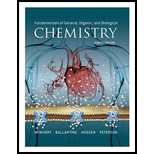
Concept explainers
Interpretation:
The reason for the secretion of the enzyme involved in blood clotting as zymogens has to be given.
Concept Introduction:
Blood is a body fluid which flows through the body in the circulatory system.
Blood clot:
- Consists of blood cells trapped in a net of the insoluble fibrous protein known as fibrin.
- It is a multistep process requiring participation of 12 clotting factors.
The formation of blood clot is triggered by two pathways which are intrinsic pathway and extrinsic pathway. Intrinsic pathway starts when blood makes contact with the protein collagen and the extrinsic pathway begins when the damaged tissues releases a membrane glycoprotein known as tissue factor.
Zymogen: Zymogen can be defined as the compound that becomes an active enzyme after a chemical change. Some enzymes can destroy the organ in which they are produced and they are often synthesized as proenzymes or zymogens.
Want to see the full answer?
Check out a sample textbook solution
Chapter 29 Solutions
Fundamentals of General, Organic, and Biological Chemistry - With Access
- Why is it that intravenous infusion of glucose is given to a patient?arrow_forwardTumor cells often lack an extensive capillary network and must function under conditions of limited oxygen supply. Explain why these cancer cells take up far more glucose and may overproduce some glycolytic enzymes.arrow_forwardExplain why the proteins involved in blood clotting, fi brin and thrombin, are fi rst synthesized as the zymogens fi brinogen and prothrombin, respectively.arrow_forward
- Many individuals with metabolic diseases, such as PKU, are normal at birth but show symptoms shortly thereafter. Why?arrow_forwardWhy is a diet dominated by fructose consumption a majorcontributing factor for cardiovascular disease?arrow_forwardIs there non-functional leukopoiesis in Leukemoid Reaction?arrow_forward
- As less glucose is available due to a low carb diet what happens to the ability of the TCA cycle to proceed?arrow_forwardGive the biological activities and occurrence of prostaglandins and leukotrienes.arrow_forwardHemophiliacs who lack factor IX are sometimes given infusions of factor VII to restore normal blood clotting activity. Explain.arrow_forward
- Elevated concentration of blood ketones is referred to as _____________.arrow_forwardWhat is the role of NADPH in the protective of red blood cells from oxidative damage ?arrow_forwardWhy does the skin turn yellow when it inadvertently comes in contact with HNO3? What Happens When a Protein Undergoes Hydrolysis?arrow_forward
 Human Physiology: From Cells to Systems (MindTap ...BiologyISBN:9781285866932Author:Lauralee SherwoodPublisher:Cengage Learning
Human Physiology: From Cells to Systems (MindTap ...BiologyISBN:9781285866932Author:Lauralee SherwoodPublisher:Cengage Learning
